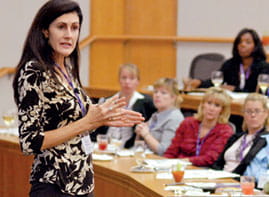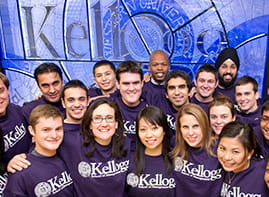The competitive advantages of diversity
On the eve of the 23rd Black Management Association Conference, Associate Professor Katherine Phillips talks about what it means to fully embrace inclusion and diversity
By Aaron Mays3/5/2010 - For Associate Professor of Management and Organizations Katherine Phillips, diversity and inclusion is more than just a corporate phrase. It’s her work and her passion.
Phillips, who is also the co-chair of the school’s Center on the Science of Diversity, recently shared her thoughts on embracing diversity in the workplace and maximizing its reward.
In corporate settings, the idea of “diversity” is sometimes misunderstood and undervalued. What is the competitive advantage of having a diverse workforce?
One of the things you have to understand is the history behind a lot of these diversity efforts. For many organizations, diversity efforts are rooted in equal employment opportunities and affirmative action programs. That was the precursor to the diversity and inclusion programs we see today. With that, a lot of people who hear diversity think “affirmative action” or “EEOC” without really separating diversity and inclusion efforts.
However, EEOC and affirmative action programs and diversity and inclusion programs are related but not necessarily the same thing. Organizations that have recognized this difference have made better strides with helping people understand what diversity is and the role it should play in the larger organizational context.
Diversity and inclusion efforts are really about what kind of experience people have when they get there. So, you can have all of the EEOC and affirmative-action type of programs that you want, but if people don’t find the organization to be a place where they can thrive, then you will be totally missing out on the opportunities that you have and can gain through diversity.
You have conducted research on diversity, leadership and management issues. What are some new findings that students and working professionals should keep in mind?
Diversity and inclusion efforts are about making sure that each and every member of your organization can take the knowledge from experiences they’ve had and use them to benefit the organization.
Some of my research now is focusing on why and how people manage this disclosure of personal information. Really high-quality relationships and new innovative ideas can result from people sharing things about themselves and their experiences. There’s a risk that comes with that, as well as the potential for reward. I’ve been trying to look into how people manage the risks and the rewards associated with sharing things about themselves.
I think we are evolving how we think about diversity and inclusion, which is leading to these questions of how we create [work] environments where everyone feels comfortable expressing themselves. And what does it mean when you want everyone to bring their full selves to the table, but also balance that with expectations of professionalism.
As organizations think about managing their own diversity and inclusion efforts, there’s a need to understand the concerns people have with the question: Can you really be inclusive? Not only working in different ways and using different work styles, but also in expressing themselves in different ways.
This weekend, the Kellogg Black Management Association will kick off its 23rd annual conference. Can you talk about the importance of continuing this tradition?
The Black Management Association Conference takes us back about 25 years to when the opportunity for Black students to get together and celebrate themselves was a novel thing. Looking at the precedents they have set with respect to embracing who they are and being their full selves in this organization, I think have become the gold standard for conferences across the country and at business schools. They have done it so well for so long that that they have established the model for how these conferences should be done.
This helps students in organizations like the Indian Business Association or the Chinese Business Association think about who they are in the business world.
Diversity is more than a one-time initiative. How can companies make sustainable efforts?
As companies think about diversity and inclusion efforts, they should recognize that diversity needs to play a central role in the company’s strategy and culture.
It has to be woven into everything a company does. So ultimately diversity does not become just a program or an effort or a one-off thing, but a part of what an organization is.






